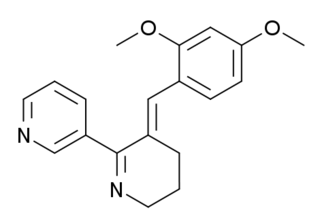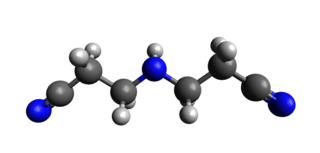Related Research Articles

Arthritis is a term often used to mean any disorder that affects joints. Symptoms generally include joint pain and stiffness. Other symptoms may include redness, warmth, swelling, and decreased range of motion of the affected joints. In some types of arthritis, other organs are also affected. Onset can be gradual or sudden.

Osteopontin (OPN), also known as bone /sialoprotein I, early T-lymphocyte activation (ETA-1), secreted phosphoprotein 1 (SPP1), 2ar and Rickettsia resistance (Ric), is a protein that in humans is encoded by the SPP1 gene. The murine ortholog is Spp1. Osteopontin is a SIBLING (glycoprotein) that was first identified in 1986 in osteoblasts.

Auranofin is a gold salt classified by the World Health Organization as an antirheumatic agent. It has the brand name Ridaura.
A TNF inhibitor is a pharmaceutical drug that suppresses the physiologic response to tumor necrosis factor (TNF), which is part of the inflammatory response. TNF is involved in autoimmune and immune-mediated disorders such as rheumatoid arthritis, ankylosing spondylitis, inflammatory bowel disease, psoriasis, hidradenitis suppurativa and refractory asthma, so TNF inhibitors may be used in their treatment. The important side effects of TNF inhibitors include lymphomas, infections, congestive heart failure, demyelinating disease, a lupus-like syndrome, induction of auto-antibodies, injection site reactions, and systemic side effects.
Type II collagen is the basis for hyaline cartilage, including the articular cartilages at joint surfaces. It is formed by homotrimers of collagen, type II, alpha 1 chains.

Heat shock protein 47, also known as SERPINH1 is a serpin which serves as a human chaperone protein for collagen.
Interleukin 35 (IL-35) is a recently discovered anti-inflammatory cytokine from the IL-12 family. Member of IL-12 family - IL-35 is produced by wide range of regulatory lymphocytes and plays a role in immune suppression. IL-35 can block the development of Th1 and Th17 cells by limiting early T cell proliferation.

Cluster of differentiation 97 is a protein also known as BL-Ac[F2] encoded by the ADGRE5 gene. CD97 is a member of the adhesion G protein-coupled receptor (GPCR) family. Adhesion GPCRs are characterized by an extended extracellular region often possessing N-terminal protein modules that is linked to a TM7 region via a domain known as the GPCR-Autoproteolysis INducing (GAIN) domain.

Leukotriene B4 receptor 2, also known as BLT2, BLT2 receptor, and BLTR2, is an Integral membrane protein that is encoded by the LTB4R2 gene in humans and the Ltbr2 gene in mice.

Transcription factor Sp7, also called osterix (Osx), is a protein that in humans is encoded by the SP7 gene. It is a member of the Sp family of zinc-finger transcription factors It is highly conserved among bone-forming vertebrate species It plays a major role, along with Runx2 and Dlx5 in driving the differentiation of mesenchymal precursor cells into osteoblasts and eventually osteocytes. Sp7 also plays a regulatory role by inhibiting chondrocyte differentiation maintaining the balance between differentiation of mesenchymal precursor cells into ossified bone or cartilage. Mutations of this gene have been associated with multiple dysfunctional bone phenotypes in vertebrates. During development, a mouse embryo model with Sp7 expression knocked out had no formation of bone tissue. Through the use of GWAS studies, the Sp7 locus in humans has been strongly associated with bone mass density. In addition there is significant genetic evidence for its role in diseases such as Osteogenesis imperfecta (OI).

GTS-21 is an investigational drug that has been studied for its potential therapeutic uses, particularly in the treatment of neurodegenerative diseases and psychiatric disorders.
The diet-induced obesity model is an animal model used to study obesity using animals that have obesity caused by being fed high-fat or high-density diets. It is intended to mimic the most common cause of obesity in humans. Typically mice, rats, dogs, or non-human primates are used in these models. These animals can then be used to study in vivo obesity, obesity's comorbidities, and other related diseases. Users of such models must take into account the duration and type of diet as well as the environmental conditions and age of the animals, as each may promote different bodyweights, fat percentages, or behaviors.

Cetyl myristoleate is a fatty acid ester or, more specifically, a cetylated fatty acid (CFA). It is the cetyl ester of myristoleic acid. Preclinical and clinical data show potential benefits in the management of arthritis and fibromyalgia.

Glycine tabacina, commonly known as variable glycine, is a scrambling plant in the bean family found in Australia. It grows in areas of high rainfall, ranging to semi-arid areas. The leaves are in threes, 7 cm long by 2 cm wide. Bluish to purple flowers form on racemes in the warmer months. The bean pod is up to 3 cm long. The habitat is among grasses, often in open country.
Lori Ann Setton is an American biomechanical engineer noted for her research on mechanics and mechanobiology of the intervertebral disc, articular cartilage mechanics, drug delivery, and pathomechanisms of osteoarthritis. She is currently the department chair as well as the Lucy and Stanley Lopata Distinguished Professor of Biomedical Engineering at McKelvey School of Engineering at Washington University in St. Louis.
Regulatory B cells (Bregs or Breg cells) represent a small population of B cells that participates in immunomodulation and in the suppression of immune responses. The population of Bregs can be further separated into different human or murine subsets such as B10 cells, marginal zone B cells, Br1 cells, GrB+B cells, CD9+ B cells, and even some plasmablasts or plasma cells. Bregs regulate the immune system by different mechanisms. One of the main mechanisms is the production of anti-inflammatory cytokines such as interleukin 10 (IL-10), IL-35, or transforming growth factor beta (TGF-β). Another known mechanism is the production of cytotoxic Granzyme B. Bregs also express various inhibitory surface markers such as programmed death-ligand 1 (PD-L1), CD39, CD73, and aryl hydrocarbon receptor. The regulatory effects of Bregs were described in various models of inflammation, autoimmune diseases, transplantation reactions, and in anti-tumor immunity.
Tolerogenic therapy aims to induce immune tolerance where there is pathological or undesirable activation of the normal immune response. This can occur, for example, when an allogeneic transplantation patient develops an immune reaction to donor antigens, or when the body responds inappropriately to self antigens implicated in autoimmune diseases. It must provide absence of specific antibodies for exactly that antigenes.
Interleukin-38 (IL-38) is a member of the interleukin-1 (IL-1) family and the interleukin-36 (IL-36) subfamily. It is important for the inflammation and host defense. This cytokine is named IL-1F10 in humans and has similar three dimensional structure as IL-1 receptor antagonist (IL-1Ra). The organisation of IL-1F10 gene is conserved with other members of IL-1 family within chromosome 2q13. IL-38 is produced by mammalian cells may bind the IL-1 receptor type I. It is expressed in basal epithelia of skin, in proliferating B cells of the tonsil, in spleen and other tissues. This cytokine is playing important role in regulation of innate and adaptive immunity.
Tolerogenic dendritic cells are heterogenous pool of dendritic cells with immuno-suppressive properties, priming immune system into tolerogenic state against various antigens. These tolerogenic effects are mostly mediated through regulation of T cells such as inducing T cell anergy, T cell apoptosis and induction of Tregs. Tol-DCs also affect local micro-environment toward tolerogenic state by producing anti-inflammatory cytokines.

IDPN (3,3'-iminodipropanenitrile) is a neurotoxin with ototoxic and hepatotoxic effects. It causes irreversible movement disorder.
References
- ↑ Williams, RO (2004). "Collagen-induced arthritis as a model for rheumatoid arthritis". Tumor Necrosis Factor. Vol. 98. pp. 207–16. doi:10.1385/1-59259-771-8:207. ISBN 978-1-59259-771-0. PMID 15064442.
{{cite book}}:|journal=ignored (help) - ↑ Brand, DD; Latham, KA; Rosloniec, EF (2007). "Collagen-induced arthritis". Nat Protoc. 2 (5): 1269–75. doi: 10.1038/nprot.2007.173 . PMID 17546023.
- ↑ Arthritis in mice induced by a single immunisation with collagen